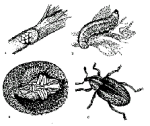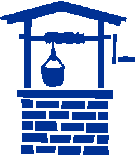

To send a message to an author, click on the author's name at the end of the article.
This Month in Ag Connection | Ag Connection - Other Issues Online

Warmer than normal winter temperatures will allow for greater numbers of alfalfa weevil eggs to be laid and for better survival of these eggs. Although high numbers of eggs present in the spring do not always result in economic infestations, there is the potential for damage. Alfalfa weevil eggs develop and eventually hatch after accumulating about 300 degree-day heat units based on 48°F. This means that infestations of alfalfa weevil larvae often occur first on south-facing slopes of alfalfa fields because these slopes warm faster in spring.
Producers in central Missouri should begin scouting for alfalfa weevil now. The first damage observed will be small feeding holes in alfalfa leaflets as they grow out of the terminals of plant stems. This minor foliage damage is caused by the first and possibly second larval (worm) stages called instars. As larvae grow larger (third and fourth instars), they consume greater amounts of plant tissue and may cause economic loss.
Scouting for alfalfa weevil is accomplished by randomly collecting 50 alfalfa stems (10 stems at 5 different locations) and tapping them into a white bucket. Larvae will generally be dislodged by this action and allow for an average number of larvae per alfalfa stem to be calculated. Caution should be used when collecting stems as larvae can be easily dislodged from the growing tip of the plant stem by rough handling. It is recommended that the top of the alfalfa stem be cupped in one hand while the plant stem is removed by cutting with a knife near the base of the stem. If an average of one or more larvae per stem is found, then the economic threshold has been reached and control is justified. The main management option for early infestations of alfalfa weevil larvae on small alfalfa is an application of a labeled insecticide. As the alfalfa crop moves closer to the developmental stage appropriate for harvest (1/10 th bloom), additional options become available for management of this pest insect. Call your local University Extension Center for recommendations on control.
(Author: Wayne Bailey, Entomology Spec., UMC)
This Month in Ag Connection | Ag Connection - Other Issues Online

Livestock producers should be sure to adequately supplement their animals with magnesium (Mg). The reason is to prevent grass tetany - a deadly nutritional disorder characterized by low blood magnesium, especially in beef cattle. It is also called grass staggers, wheat pasture poisoning and hypomagnesemia. Grass tetany primarily affects older cows nursing calves under 8 weeks of age, but can affect young or dry cows and growing calves as well. It happens mostly when cattle graze lush, immature grass or small grains (wheat) like those found in the early spring, but can occasionally occur when cattle are fed dry forages.
If cattle exhibit any of the following signs, they might be suffering from grass tetany. Symptoms include:
According to Nebraska researchers, there could be several reasons why cattle have low blood magnesium including:
According to Texas A & M researchers some soil conditions can also propagate this disease as well. These soil types include:
Researchers have a few suggestions to keep livestock from getting grass tetany:
If your cattle express symptoms of grass tetany, call your veterinarian.
(Author: Wendy R. Flatt, Livestock Specialist)
This Month in Ag Connection | Ag Connection - Other Issues Online

With the arrival of spring, many Missourians are heading outdoors to start working on a list of home and yard improvement projects. Whether it's planting a new shrub or tree, building a new fence, adding a deck to a house, tilling a new garden spot or some other project that requires digging by shovel or using excavation equipment, one should take time to call and have underground utilities marked first.
To the most careful person, the act of planting a tree around the home may seem harmless. However, the underground area around most homes can be a tangled maze of utilities including water, sewer, cable TV, electricity, phone and natural gas lines/cables/pipes. Digging into any of these utilities even with a shovel can damage the utility, cause property damage, leave your home and/or your neighbor's home without services, and (in cases where gas or electric lines are damaged) personal injury or death can occur. You could also be charged for repairs.

Missouri One Call System (MOCS) was established as a means to protect underground facilities and assist excavators (contractors, homeowners or renters) and utilities in complying with Missouri's statutes. The phone number is 1-800-DIG-RITE (1-800-344-7483). It operates 24 hours a day, seven days a week.
Missouri law requires that any person excavating must notify all underground facility owners/operators that may be affected by the excavation at least two but not more than ten working days in advance, except in the case of an emergency. Lack of planning on your part does not constitute an emergency on their part. If utility companies have buried services on your property and are not members of MOCS, it is your responsibility to notify those utility companies directly.
Once your information is processed by MOCS, you will be given a list of member utility companies that will be notified of your excavation. Your information is also sent to all member utilities with facilities in your dig site area. Whoever is conducting the dig work will be asked to provide information on what work will be done (planting trees, installing fence, constructing or adding onto a house), depth of excavation and equipment used.
Additionally, you should be prepared to provide the following information:
If the excavation is within city limits:
If the excavation is outside city limits:
The MOCS operator will provide the caller with a contact verification number. This number should be kept in a safe location as proof that the MOCS has been notified. If damage is sustained in the excavation process, having the contact number will protect the excavator by reducing or eliminating the liability of repair costs.
In addition to notifying MOCS or individual utility companies, marking the planned excavation site with white paint will aid the utility representatives in knowing your construction or project location. This action will help both parties work together to ensure no unintentional damage is done. After the utility has been notified of the planned excavation, they will mark the "approximate location" of their underground lines with the corresponding legal color codes (flags and/or paint) or advise you there are no facilities in your area. The utility will also leave a notice of any special instructions that need to be followed when digging, such as, hand digging required or having a representative of the utility present during excavation. "Approximate location" is defined by Missouri law as the width of the underground facility plus two feet on either side thereof.
Color Codes Required By Law
| Electric | Red |
| Gas/Oil/Steam | Yellow |
| Water | Blue |
| Sewer | Green |
| Temporary Survey Markers | Fluorescent Pink |
| Proposed excavation | White |
| Reclaimed water | Purple |
In any of the following situations, the caller should contact the facility owner(s) directly:
To contact Missouri One Call System on a planned dig or excavation call 1-800-344-7483 or to learn more about MOCS visit the Internet site http://www.mo1call.com/.
(Author: Darin Starr, Natural Resource Engineer)
This Month in Ag Connection | Ag Connection - Other Issues Online
An estimated 150,000 to 300,000 abandoned wells in Missouri, which if left unplugged, are a threat to children and a potential site for groundwater contamination.

If a well is not properly sealed, children or even adults can be at risk from falling into the them. Agricultural and lawn care chemicals, livestock waste and other contaminants can filter through abandoned wells to contaminate groundwater supplies.
Under Missouri law, it is the landowner's responsibility to properly plug an abandoned well. Landowners can plug their own wells if they follow state rules.
The landowner should know the total depth, length of casing and depth to water before plugging the wells. If the landowner does not know or cannot find out these details, he or she should hire a permitted well installer or pump contractor.
There are different kinds of abandoned wells. Dug wells or cisterns may be three to six feet in diameter and 15 to 50 feet deep. They can be plugged by pushing in the upper few feet of well lining and filling the well to within three feet of the surface with chlorinated clean fill such as coarse gravel or rock. Clay-rich soil can then be mounded over the gravel or rock to complete the job.
Wells bored with an auger, scoop or dragline usually have large diameters, making them as dangerous as abandoned dug wells. Bored wells can be plugged using the same methods for dug wells and cisterns.
Abandoned drilled wells, though not usually a safety hazard, can let contaminants enter the groundwater system.
The best way to plug a drilled well is to cut the casing off three feet below the surface and fill the well from the bottom to top with a Portland cement/water mixture, bentonite grout or chipped bentonite. This material must be inserted through a grout pipe placed into the bottom of the well and not poured from the surface. Clean fill used at the bottom of the well should be chlorinated to prevent bacteria from entering the aquifers.
It's a good idea to have a permitted installer do this work to make sure it's done correctly.
Missouri requires landowners to register plugged, abandoned wells by submitting proper forms to the Missouri Department of Natural Resources' Geological Survey and Resource Assessment Division.
The Missouri Department of Natural Resources has a well plugging bulletin and registration form on their website: http://www.dnr.state.mo.us/geology/geosrv/plugging.htm
(Author: Bob Broz, Water Quality Specialist, UMC)
This Month in Ag Connection | Ag Connection - Other Issues Online
Publishing Information
Ag Connection is published monthly for Northeast and Central areas of Missouri producers and is supported by the University of Missouri Extension, the Missouri Agricultural Experiment Station, and the MU College of Agriculture, Food and Natural Resources. Managing Editor: Mary Sobba.